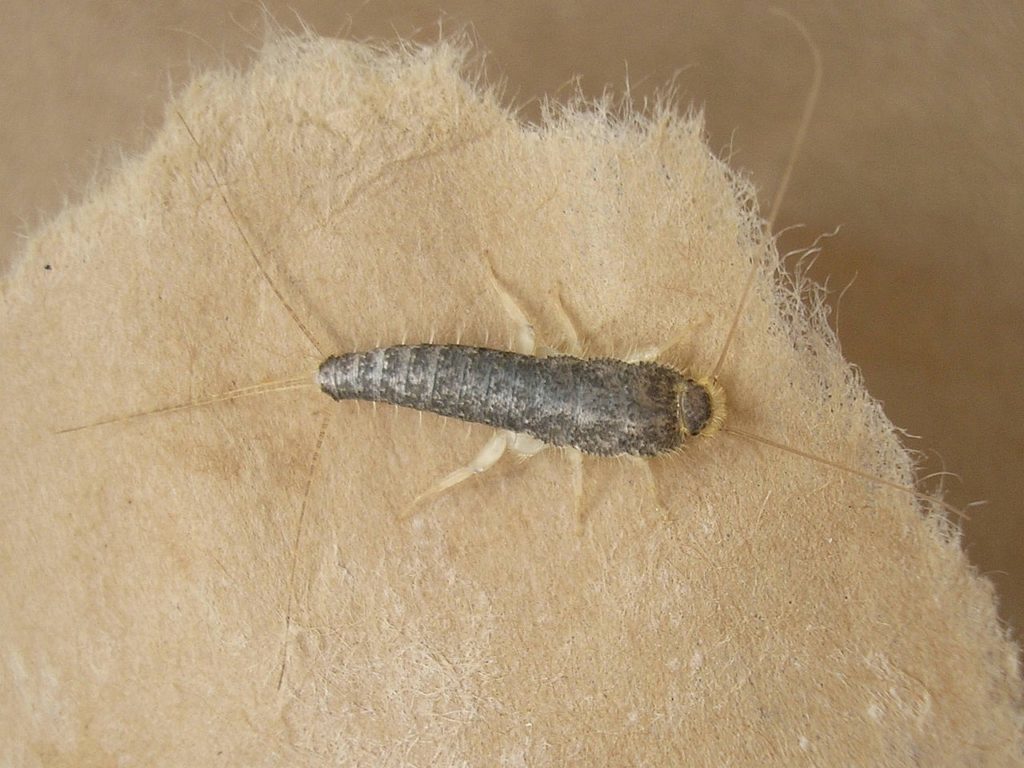You move a cereal box and realize that something has moved right along with it. The insect is too small to be a mouse and too bright to be a cockroach. You push another object on the counter and see what appears to be a wingless fish. You, good friend, have a silverfish infestation.

What Are Silverfish?
Silverfish get their name from their coloration and overall appearance. The insects actually carry the scientific name “Lepisma saccharina” belonging to the Zygentoma family. Silverfish do not have wings and are nocturnal creatures that typically reside in buildings where cracks and crevices reign supreme. It is not uncommon for these insects, measuring anywhere from 13-25mm long, to also hang out around moist areas such as the kitchen or bathroom. Most silverfish, however, spend their days and night in darkness.
Where Do They Come From?
When looking into the origins of these beautiful yet annoying creatures, you will find that silverfish are cosmopolitan species that are often found in Africa, North and South America, Australia, and Eurasia. These regions foster the most significant populace of silverfish because they have environments that are moist with humidity ranging from 75 to 95 percent.
You may experience more encounters with silverfish if you live in an urban area of any one of these regions. Attics, basements, bathtubs, and sinks are ideal breeding grounds for these odd-looking creatures. Silverfish also love old books and other vintage products that don’t get enough attention.
Like cockroaches and other household pests, silverfish prefer the bathroom and kitchen. There is practically an unlimited amount of water and food in both of these areas in the house, which is why you may find a cluster of the insects harboring underneath your bathroom sink or somewhere near your refrigerator. You should be aware that silverfish are nocturnal insects. If you see these insects lurking around during the day, then you probably have a pretty severe infestation.
What Do Silverfish Eat?
Silverfish have destructive feeding habits that thrive off carbohydrates and such as various sugars and starches.
When you think of sugar and starch, you immediately zero-in on rice and granulated sugar. It is accurate to assume that silverfish go after these sorts of goods, but it is not smart to think that’s all they eat. In actuality, silverfish thrive off shampoo, the glue that holds the pages of books together, and paper in general. They also find their way into unopened food packages that you purchase from your local grocery store.
How Do Silverfish Infestations Begin?
Many homeowners unknowingly bring silverfish into their homes after doing a good shop at the grocery store. Your favorite product maker has no idea of how bad their infestation at the factory has gotten and, hence, don’t think to be more intentional with their preventative measures. You, as the unknowing and innocent consumer, purchase a box of cereal and, just like that, have opened yourself up to the merciless critters who wreak havoc on your antiques and pantries.
You also invite silverfish by providing them with moist spaces such as basements and crawl spaces that give them a place to stay during the day and at night. The pests usually enter your home through foundational cracks or torn screens and thrive off your everyday bad habits such as leaving dirty dishes in the sink or forgetting to dust every day.
How Do You Know That Silverfish Have Set up Shop?
Many homeowners do not realize that they have a silverfish infestation until they discover one of the critters out in the open. It is usually too late by then to take light steps towards ridding the home of such terrible pests. Many homeowners are not aware that silverfish leave feces that resemble pepper scraps everywhere they go that, if detected in time, could save hundreds in treatment.
How Bad Would It Be to Have a Silverfish Infestation?
Perhaps you are one of those people thinking, “How bad could it be to live with the wingless creatures? It’s not like they bite.” No, silverfish do not bite or sting, but they do taint your living environment.
A silverfish infestation could lead to increased allergies in those who are already vulnerable. You may also find yourself battling with other pests such as beetles if you choose to cohabitate with silverfish. As with every unwanted guest, silverfish have the potential to cause extensive damage to your valuables. Your antiques are not safe so long as these disgusting pests are lurking around.
Preventing and Treating Infestation
One of the best ways that you can avoid a silverfish infestation is by being aware of and controlling humidity. Consider opening vents in crawl spaces and basements to prevent the formation of moisture. It is also a good idea to keep a strict cleaning schedule to keep silverfish from feeding off leftover food and multiplying.
It does not take long for silverfish to set up shop and grow in number. Such is the reason why it is crucial that you contact your local Montreal exterminator at the sight of one (yes, one) of these critters.
Many homeowners have waged war with silverfish and lost because they did not understand the need to rid the residence of both adult insects and their harborage. A professional exterminator in Montreal knows what it takes for you to break free of silverfish. He can help you regain control of your home.